The Chinese Crested Dog is an image, indoor breed, the representatives of which are divided into two types: hairless individuals with a completely naked body and downy ones, overgrown with long silky hair
The Chinese Crested Dog is a miniature clever girl with a stylish “hairstyle”, a constant companion of Hollywood divas and starlets of the mid-20th century. Having a lively, gentle character and pathological attachment to the owner, the KHS, although they declared themselves only at the beginning of the last century, managed to masterfully adapt to the realities of their time and gain enviable popularity. Since about the 70s, the breed began to smoothly descend from the stellar Olympus, thanks to which its representatives began to appear not only at closed bohemian parties but also in the apartments of ordinary people around the world.
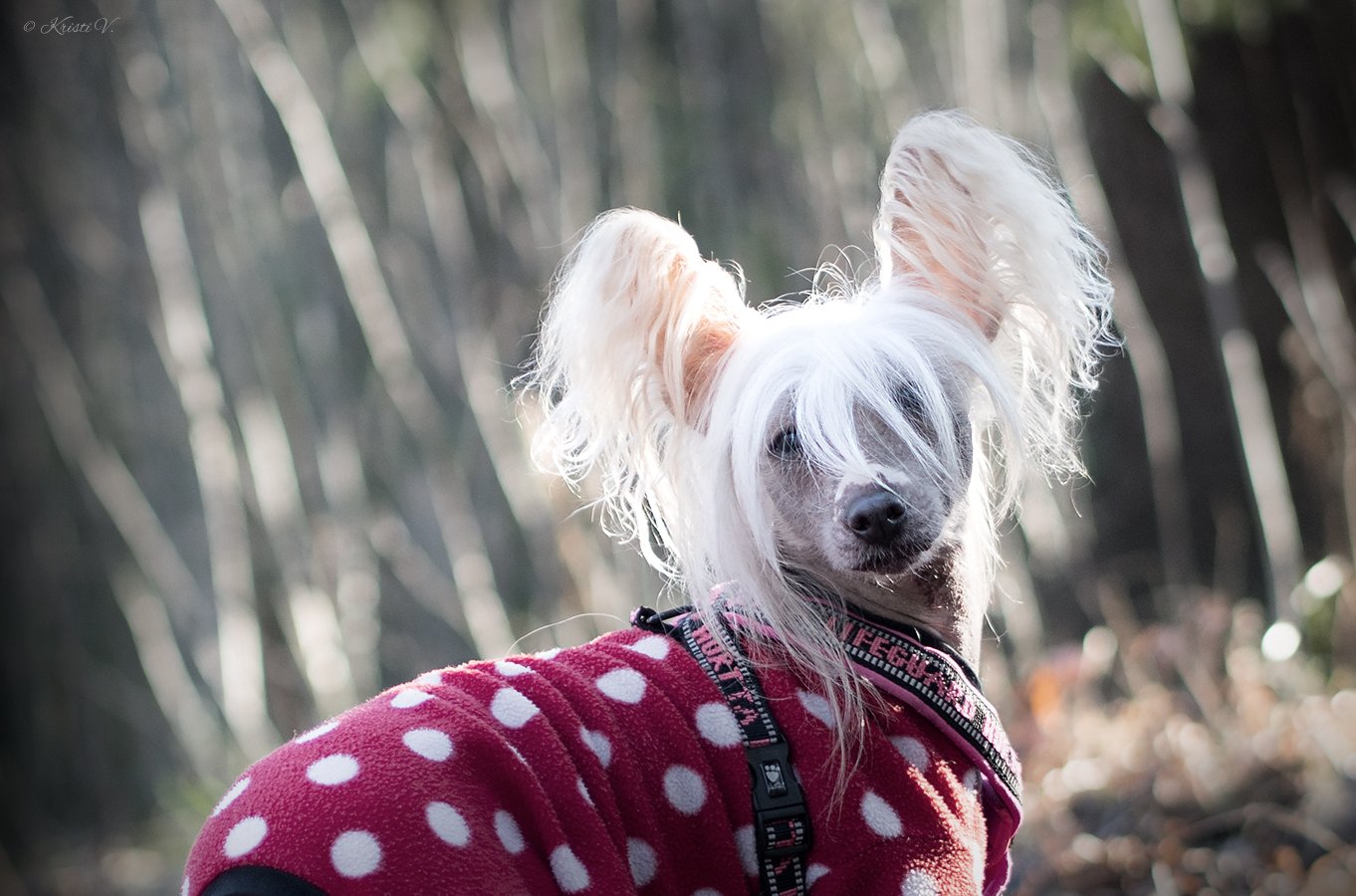
Direct evidence that the Celestial Empire was the homeland of the Chinese Crested has not yet been found. Yes, Asian nobles have always been susceptible to live exotic and traditionally preferred small hairless dogs, but most of these pets were “foreigners” imported from other countries. Speaking specifically about CCS, modern researchers offer three relatively plausible versions of their origin. According to the first of them, the miniature is direct descendants of the extinct African hairless dog that sailed to China with trade caravans. The second theory is based on the external resemblance of the “Chinese chat” to the Mexican hairless dog. True, it is not entirely clear in what ways animals from the unknown American continent at that time made their way to Asia. The third possible homeland of Chinese hairless crested dogs is called the territory of modern Thailand and Sri Lanka, whose inhabitants have been trading with China since time immemorial and, accordingly, had the opportunity to float their four-legged wards there.
The modern stage of the formation of the breed came at the end of the 19th century when the New York journalist Ida Garrett brought the first “Chinese” to the USA. The woman was so enraptured by decorative “crested” that she devoted 60 years of her life to breeding them. At the beginning of the 20th century, professional breeders also became interested in pets. In particular, the American breeder Deborah Woods started the first herd book of the Chinese Crested in the 30s of the last century. In 1959, the first club of KHS fans appeared in the USA, and in 1965 one of Mrs. Woods’ charges went to conquer Foggy Albion. British breeders also did not remain indifferent to exotic dogs, as evidenced by the opening of numerous kennels in different parts of England in the period from 1969 to 1975. At the same time, the red tape with the recognition of the breed by canine associations dragged on for a long time. The first to capitulate in 1981 was the KC (English Kennel Club), and 6 years later, the FCI, which approved the right of the Chinese Crested for breeding, was drawn up to it. The AKC (American Kennel Club) held out the longest, proclaiming the “Chinese” an independent breed only in 1991.
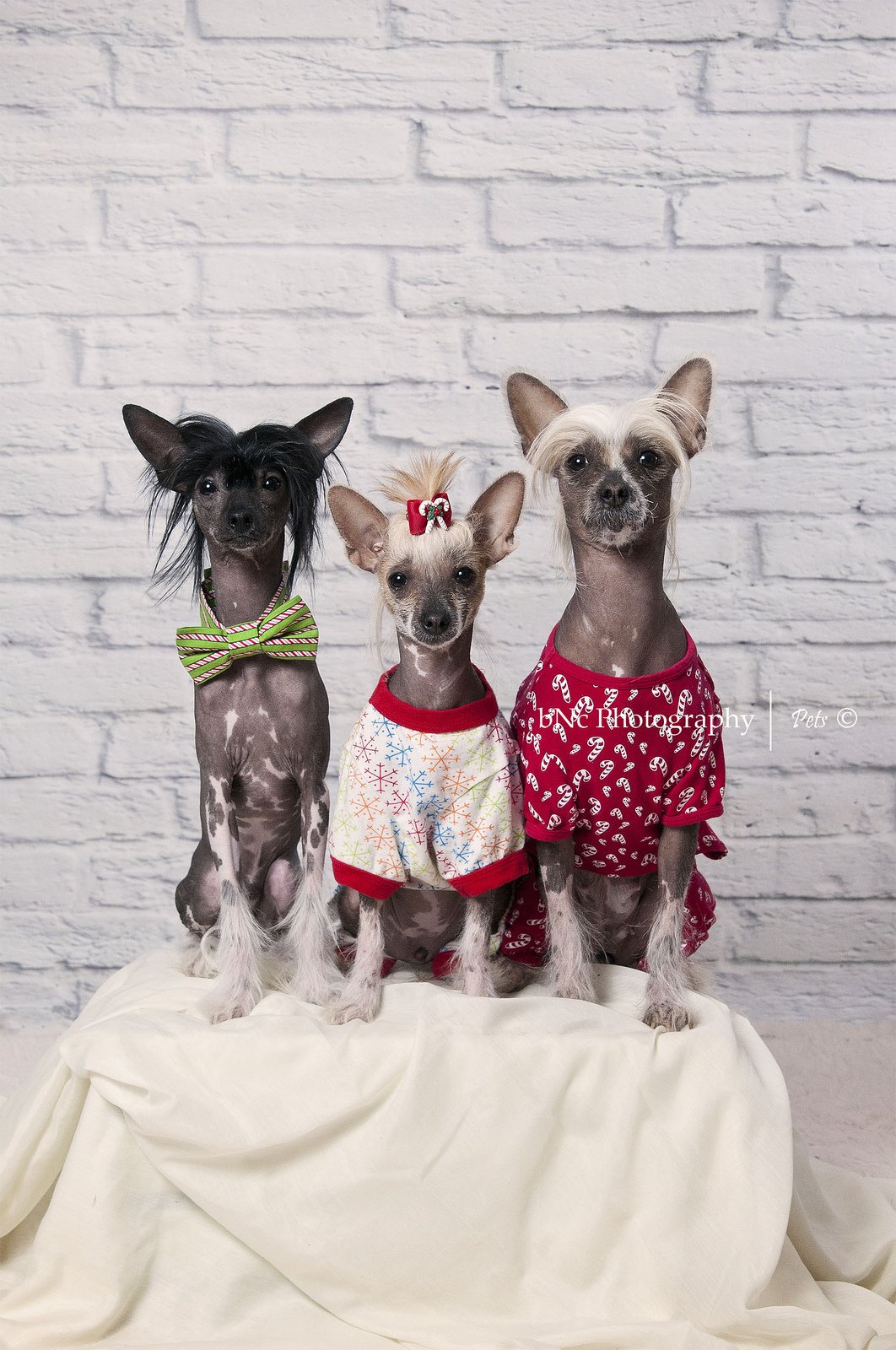
The Chinese Crested Dog is not the most convenient breed to keep, but this drawback is fully compensated by the non-trivial image of its representatives. According to the standard approved by the FCI, the Chinese Crested can be deer or stocky. Individuals from the first category are distinguished by a lightweight skeleton (skeleton) and, accordingly, great grace. Stocky animals are almost twice as heavy as their counterparts (the weight of an adult dog can reach 5 kg) and squat.
The head is slightly elongated, the cranium is moderately rounded, the cheekbones are not convex. The muzzle is slightly narrowed, the stop is moderately expressed.
The jaws of the Chinese Crested are strong, with a correct bite (the lower teeth are completely covered by the upper ones). In hairless individuals, molars often do not erupt, however, such a deviation from the standard is considered quite acceptable since it is genetically determined.
The nose is medium in size, color can be any.
The ears are comparatively large and set erect. An exception to the rule is the Chinese crested downy type, which may have a hanging ear canopy.
They have small eyes, wide-set, and very dark eyes.
The neck is dry, long, with a graceful curve, which is especially noticeable in a moving animal.
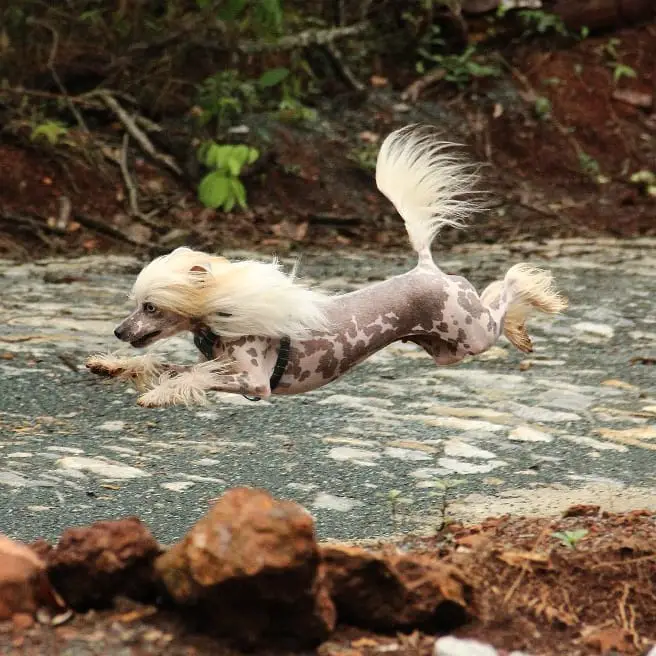
The length of the body of individuals of the deer and stocky types varies greatly. In the first case, the body will be of normal proportions, in the second – elongated in length. The chest of the representatives of the Chinese Crested breed is wide, the ribs are slightly curved, the belly is tucked up.
The forelegs of hairless Chinese Crested dogs are straight and slender. The shoulders are narrow and “look” back, and the pasterns are miniature and stand almost upright. The hind legs are straight, with muscular thighs and low hocks. The paws of the Chinese crested hare type, that is, narrow and elongated in length. The toes are covered with “boots” made of airy wool.
The tail is long, straight type, with a spectacular plume of soft wool. When moving, it is kept raised, at rest, it is lowered.
Ideally, hair of naked “crested” should be present only on the legs, tail, and head, although there are often exceptions to the rule. Powder puffs are completely overgrown with soft, veiled hair, under which a small undercoat is hidden. At the same time, both hairless and downy dogs have a charming “forelock” on their heads.
In the world cynology, all types of colors of Chinese crested dogs are declared permitted. Inhabitants of Russian nurseries have only 20 officially recognized colors:
- solid white;
- White black;
- blue and white;
- white and chocolate;
- white and bronze;
- white and cream;
- solid black;
- black and white;
- black and tan;
- solid cream;
- creamy white;
- solid chocolate;
- solid bronze;
- bronze with white;
- sable;
- chocolate with white;
- chocolate and tan;
- solid blue;
- blue with white;
Important: naked, downy, in a deer or stocky type – all these varieties of Chinese crested are equal in rights, so a dog can be disqualified at an exhibition only for its discrepancy with the breed standard, but not for its external features.
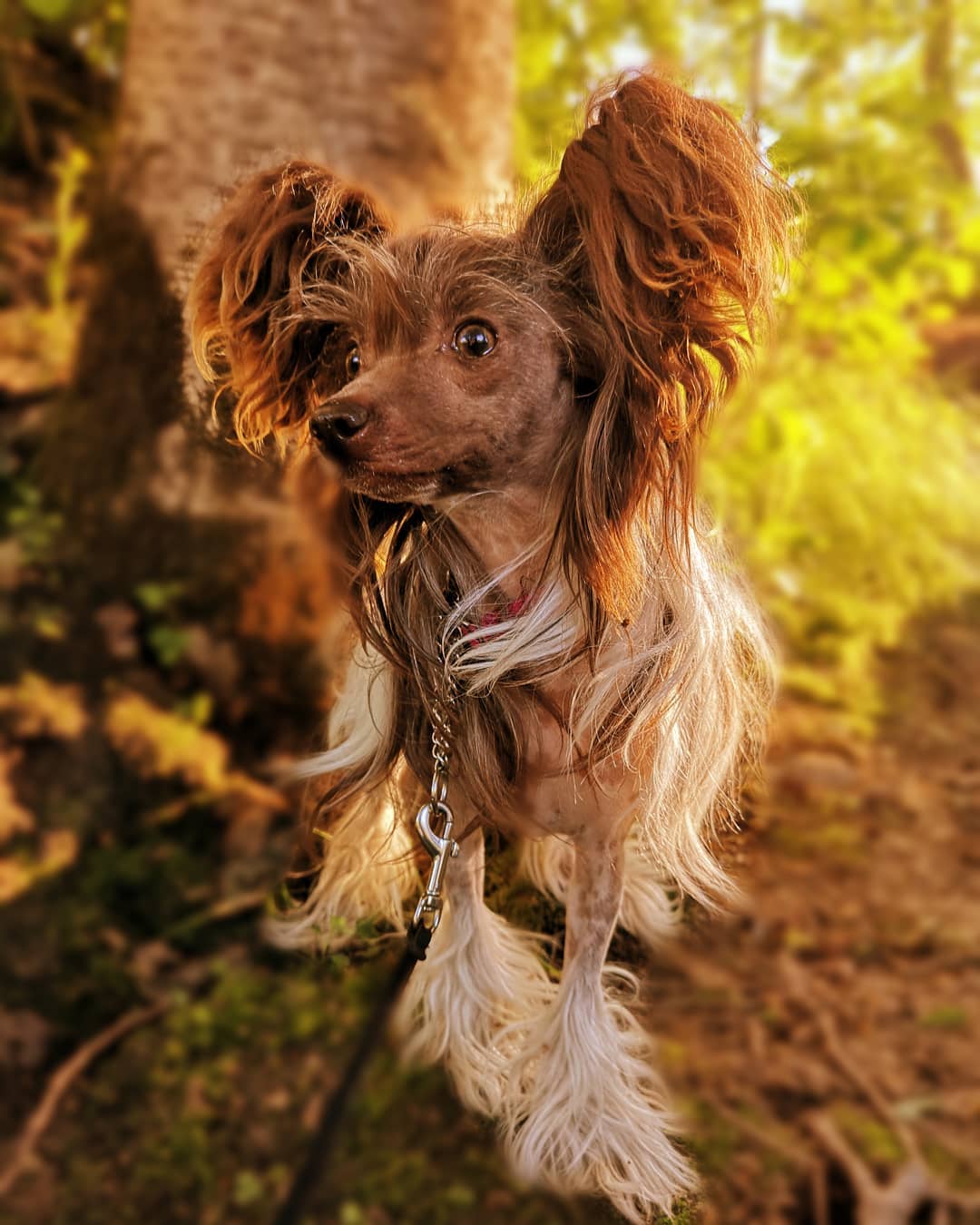
Sociable, benevolent, adoring her own owner – if your CCS does not possess at least these three qualities, think about whether it is really a Chinese crested. The breed’s amazing attachment to humans has given rise to several myths about its mental talents. So, for example, many owners of “Chinese chats” are seriously convinced that their pets have a tendency to telepathy and can anticipate desires.
There are also many stories about the so-called “healing” of the breed. True, this refers more to “naked”, whose skin seems hot due to the lack of wool on it. According to the owners, hairless Chinese crested dogs soften the pain in arthrosis and rheumatism, acting as a living heating pad. It is difficult to judge how true such stories are, but the fact that KHS really knows how to create a harmonious, pacifying atmosphere in the house is a proven fact.
One of the main phobias of the Chinese Crested breed is loneliness. An animal left for a long time in an empty apartment literally goes crazy, notifying others about its misfortune with a loud howl. However, to bark heartily, “puffs” and “naked” do not always need a reason, so if at some point your pet is carried away by “oratorios”, take up his upbringing. But do not overdo it: it will still not be possible to turn a crested vocalist into a silent one.
Representatives of this breed are not attached to the sofa and are quite mobile. The back seat of a car, a bicycle basket, or a regular leash – choose any method you like and feel free to take your pet out or out. In addition, mischievous “crests” are always happy to play with a ball, squeaker, and other dog entertainment. Well, if someone from the household, including children, joins the process, there will be no limit to the joy of the “Chinese”.
Love for a person often reaches the point of obsession. Puppies intuitively copy feline behavior: rub against their legs, try to perch on their knees, and play hugs with their adored owner. Trying to cultivate emotional coldness and gravity in Chinese crested is useless, and for the psyche of an animal, it is also deliberately harmful. If the prospect of constant close contact with a pet seriously bothers you, you will have to opt for another, less sociable breed.
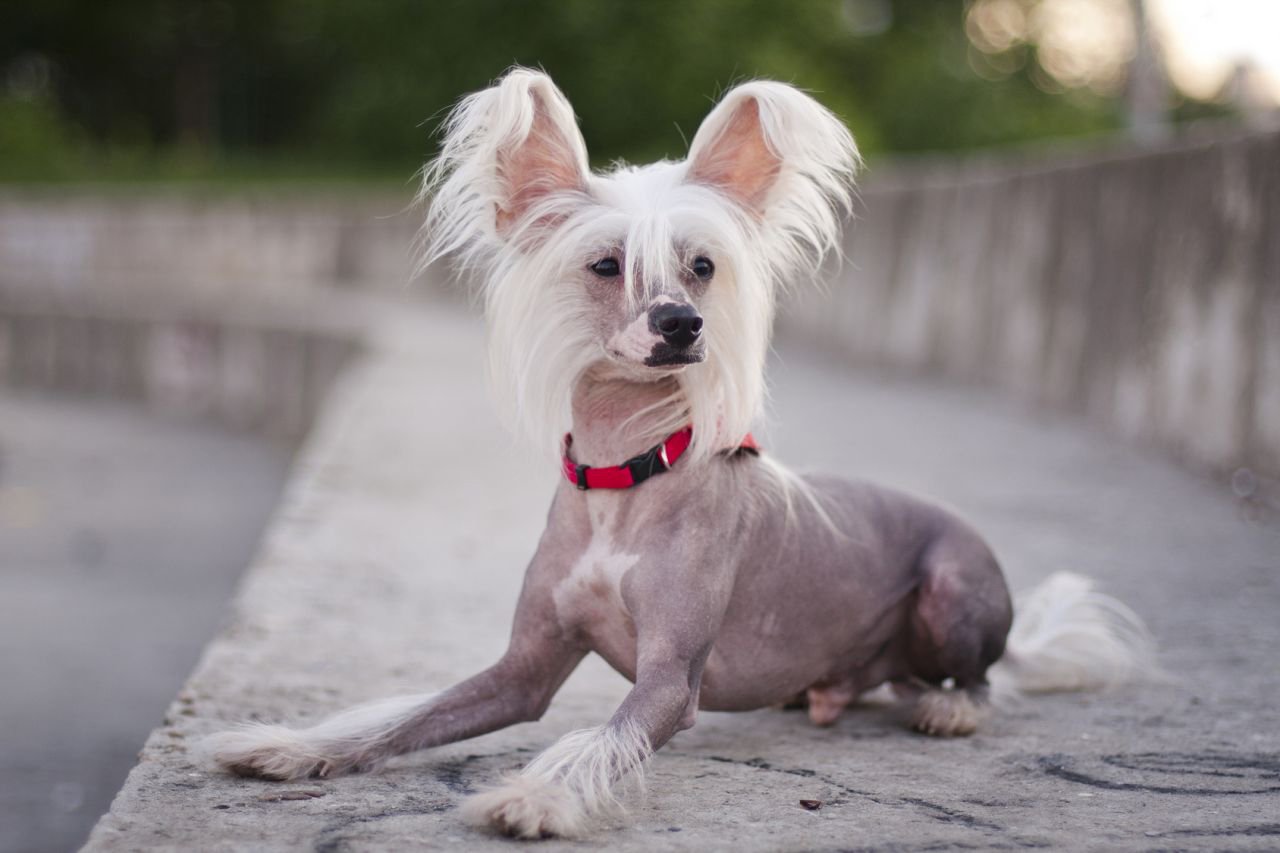
Quite often at zoo forums, one can come across complaints about narrow-mindedness and poor upbringing, although in fact are smart, inquisitive, and quite learning creatures. And yet not a single dog, even the most intellectually developed dog, will train itself, so if you expect an innate sense of tact and behavioral aristocracy from an animal, then it is completely in vain.
The upbringing of a puppy begins from birth or the first minutes of his appearance in the house. To begin with, accustom your baby to a place and do not let him climb into your bed (yes, KHS are exceptional charms, but they should sleep on their own couch). If the puppy misses his mother and brothers too much, at first a heating pad is placed on his mattress, creating the illusion of a warm dog’s belly. And do not forget that the psyche of Chinese crested dogs is very fragile, so hold your own emotions in a fist and never yell at a kid who has made a mistake.
Toilet problems, which breed owners often complain about, arise mainly in individuals who have been poorly or too late explained how to use tools for canine needs. In general, the Chinese Crested are born “diapers” and “hawkers”, that is, they cannot endure for a long time and prefer to do their “business” for a newspaper or in a tray than wait for a walk. However, it is quite possible to accustom them to an outdoor toilet, and the methods are used the same as for dogs of other breeds.
Even though due to their slender build, the CCS seems to be controllable and malleable, it is still necessary to train them. In particular, the command “No!” is obliged to understand and perform every adult “Chinese”, in the same way as to approach the owner at his call. If desired, the Chinese Crested can be taught simple circus tricks. It is known that “puffs” and “naked” go well on their hind legs and whirl to the music.
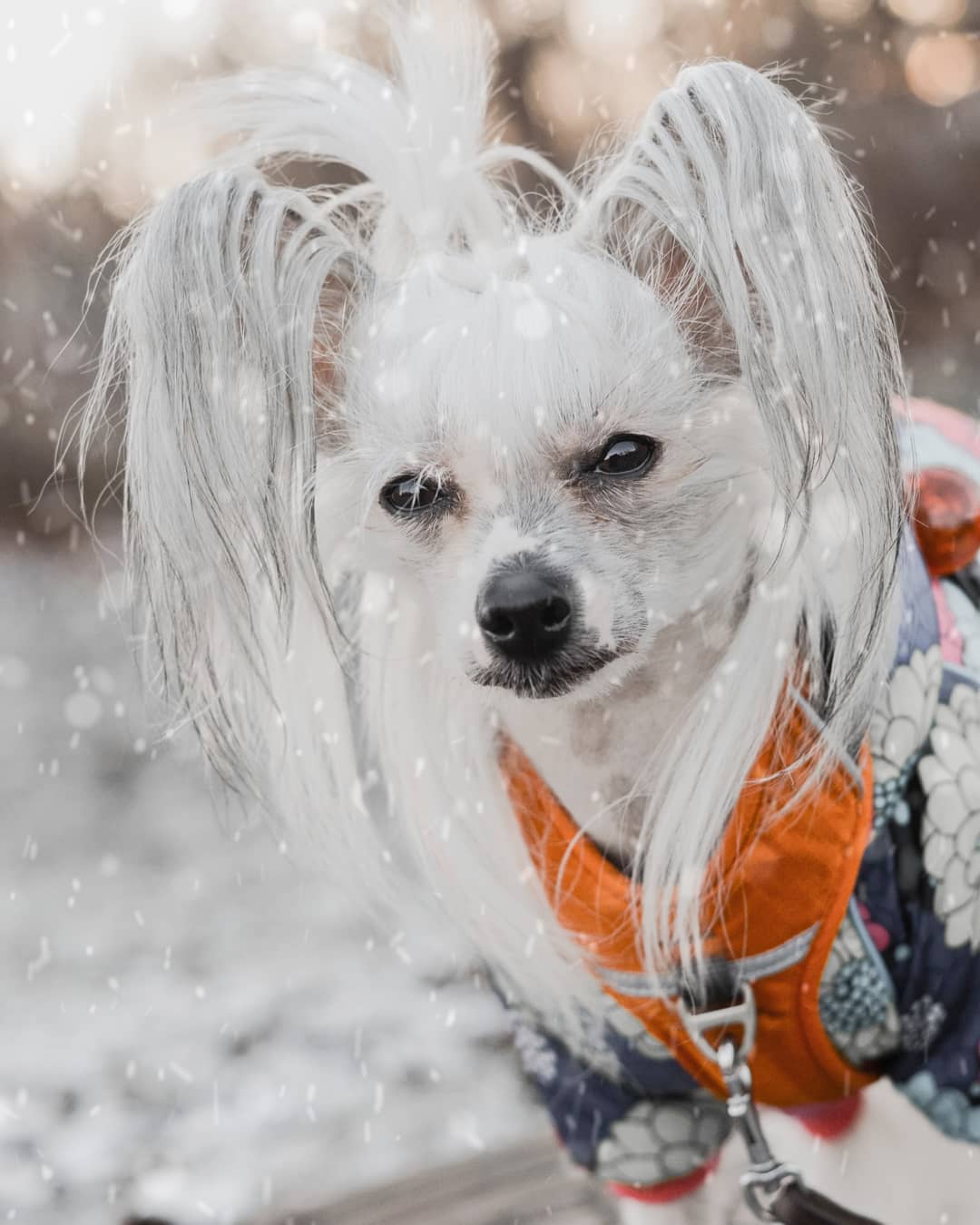
At home, your pet should feel comfortable and protected, so set up a secluded corner for him. The best option is a small house, although a bed with bumpers will also work. A growing Chinese Crested dog should have enough toys. Both rubber tweeters from the store and alternative options such as corks, tangles, and small cardboard boxes will work here. For travel to the vet or travel, it is best to purchase a carry bag.
Paradoxical as it may seem, but with the skin of “naked” no less fuss than with the wool of powder-puffs. Wash the hairless CCS once or even twice a week using a mild, hypoallergenic shampoo and conditioner. If there were no special hygiene products at hand, you can limit yourself to baby or tar soap. Drying with a hairdryer is also a must.
Blackheads and comedones, black sebaceous plugs that clog pores, must be regularly removed from the skin of naked Chinese Crestedlings. In particular, the “millet” (white balls) are pierced with a medical needle, their contents are squeezed out and the puncture site is treated with chlorhexidine. Before you start removing blackheads, the dog’s skin is steamed (a terry towel soaked in heated water and wrapped around the body of the animal is suitable). You can remove comedones with your hands, but in this case, your fingers should be wrapped in a sterile bandage soaked in an antiseptic. Acne caused by food allergies can be treated with Bepanten ointments and tea tree oil.
It is worth considering that even hairless Chinese crested dogs have a certain amount of hair on the body and stomach. Usually, these are sparse hairs that spoil the glamorous appearance of the animal, but in some individuals, there is also a thicker overgrowth. To improve the appearance of hair on the body, “naked” is removed with a disposable razor, after having lubricated the dog’s skin with shaving foam. Another affordable and painless option is depilatory creams from a regular supermarket. The epilator and wax strips give a longer-lasting result, but not all CHS can endure such “execution”. However, some breeders manage to train their pets to endure discomfort during such procedures. The main thing then is not to forget to treat the pet’s skin with an antiseptic lotion and lubricate it with an after-shave cream.
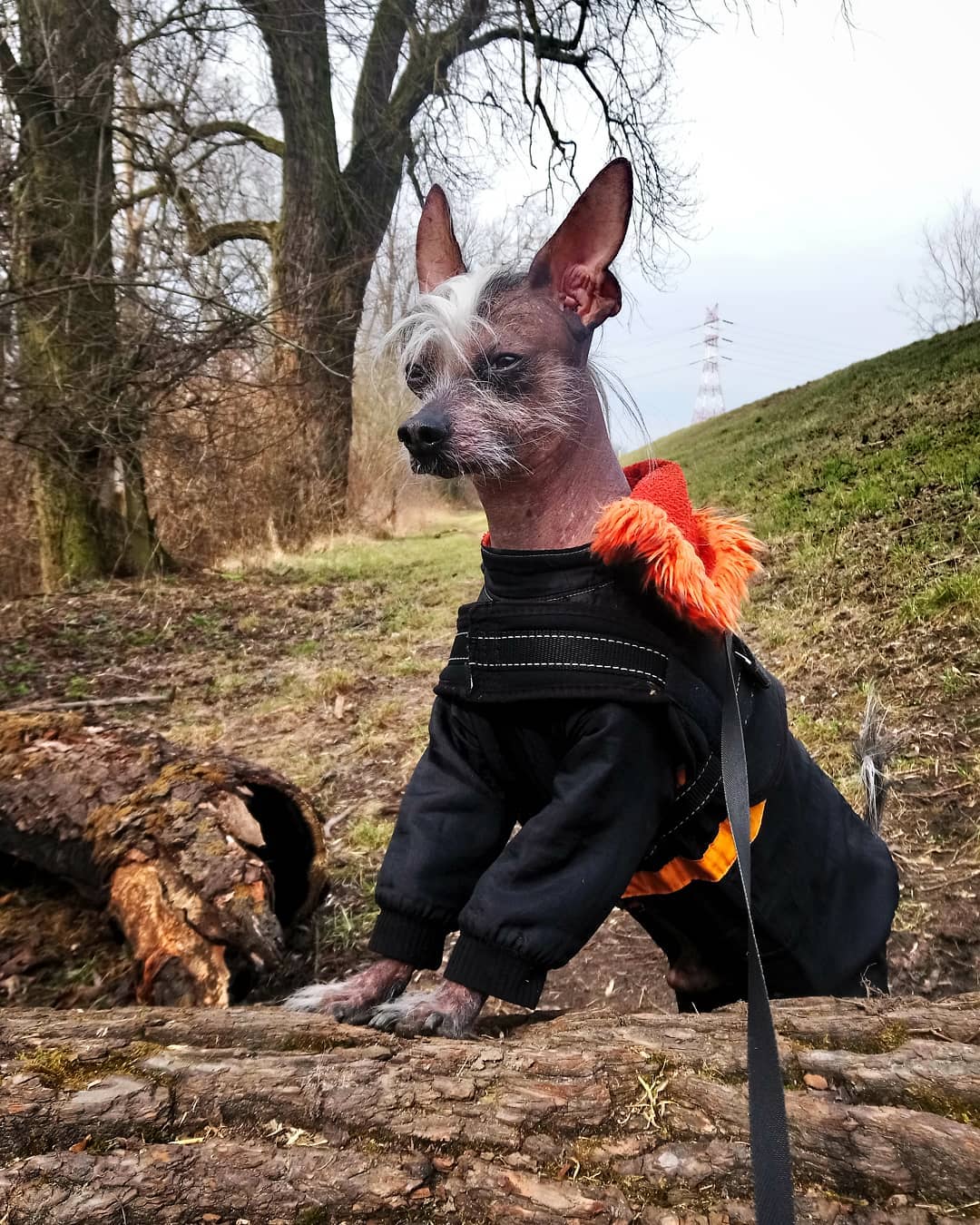
By the way, about creams. In the “cosmetic bag” of a naked Chinese crested dog, they should be mandatory, since the skin of such animals is prone to dryness and is very sensitive to environmental influences. Buy a couple of nutrients and moisturizers for your pet, and stock up on a high SPF cream for the summer.
Owners of downy Chinese also do not have to relax. Powder-puffs are washed, of course, less often than “naked” ones (2-3 times a month), but they are combed daily. The wool of “puffs” is very soft, which means that no matter how carefully you care for your pet, mats are provided. The only question is how dense they will be. If the animal is combed regularly, the tangled fur is easier to tidy up. The owners of neglected dogs have only one way out – cutting off the fallen areas. It is great if the owner has the time and free funds to take the pet to the groomer. If care is carried out at home, follow a few rules.
- Never brush dry puffs. Be sure to moisturize it with a special lotion.
- Secure the dog’s chest with an elastic band – so the hair will be less tangled.
- Choose a smooth fabric like satin for your pet’s bed. This will to some extent reduce the likelihood of knocking wool into tangles while the animal is sleeping.
Caring for the ears and eyes of Chinese Crested dogs is not the most difficult. A couple of times a week, the ear funnels of pets must be cleaned with cotton swabs and treated with veterinary lotion on the mucous membranes of the eyes (folk remedies are contraindicated). You can additionally pluck the hairs in the inner part of the animal’s ear, this will improve air circulation in it. In addition, too abundant hair interferes with the removal of sulfur deposits from the auricle.
Trimming the claws of a Chinese Crested dog will require maximum concentration. The blood vessels in the claws of the “Chinese” go deep enough, and there is a risk of hitting them with scissors. This is exactly the case when it is better to undercut than to cut off the excess.
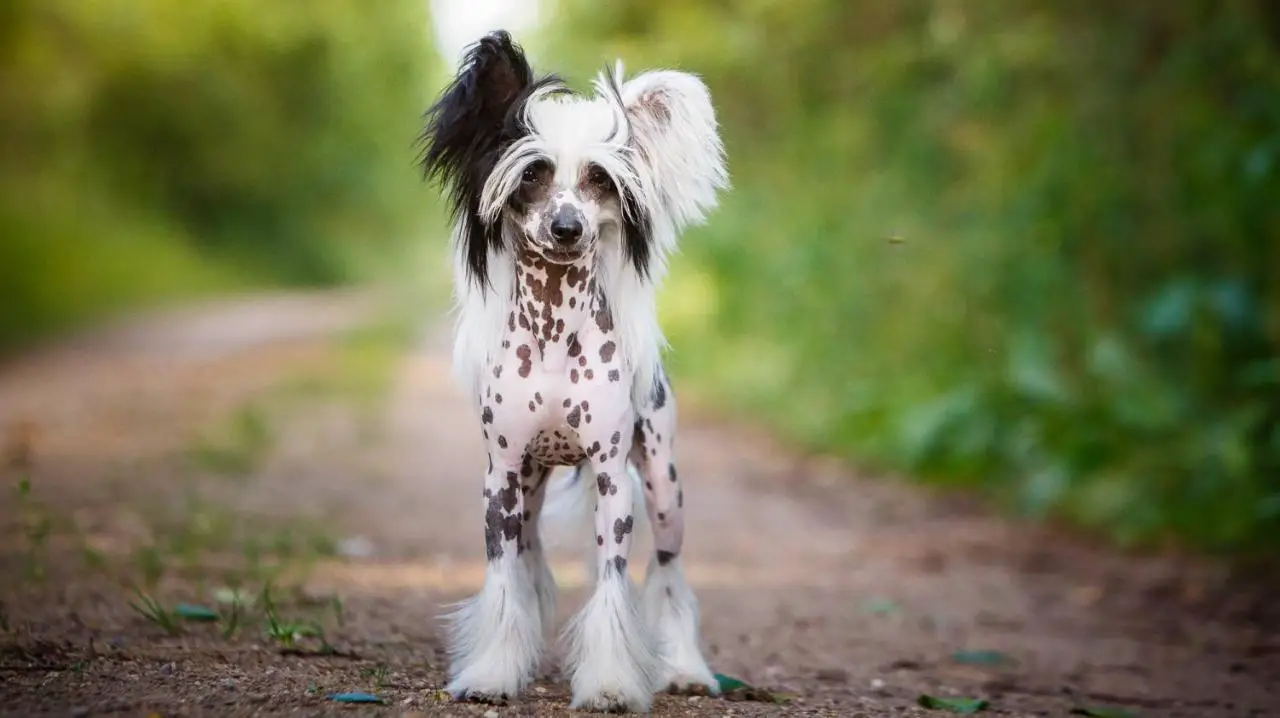
Representatives of the Chinese Crested breed should be walked daily. In the fresh air energetic and inquisitive fall into a kind of frenzy, so they lead them out on a roulette leash. And these kids love to play archaeologists and excavate in flower beds, so it will be difficult to stop the carried away dog without a leash.
Walking is usually preceded by preparation. For example, in the spring and summer period, the body of hairless dogs is smeared with sunscreen to prevent burns. In autumn and winter, animals are taken out into the street dressed (important for “naked”), and in frosty weather, it is better to minimize the number of walks.
Walking with a Chinese crested is not possible everywhere. In particular, it is not recommended to take hairless pets into the forest or go with them on a picnic to water bodies. The dog’s body, which is not protected by wool, is an excellent target for mosquitoes and other blood-sucking insects, therefore, after such a sortie, the CCS will have to be treated for bites and possible allergies. Leaving your four-legged friend to sunbathe in the sun is also undesirable. In “naked” it can provoke overheating, burns, and skin pigmentation, and in kittens under the influence of ultraviolet radiation, the hair dries up and coarsens.
The first and only rule: no unauthorized snacks and delicacies from your own table. Hairless Chinese Crested dogs have very sensitive digestion and are allergic to a whole bunch of foods, so any attempt to modify the pet’s menu invariably ends with a trip to the veterinarian. To understand that you made a mistake and fed your pet the wrong thing, you can by the condition of his skin and coat. Pimples, wen, smudges under the eyes are not the worst symptoms yet. It is much worse if the Chinese Crested dog vomits after your meal.
Strict no:
- raw meat and fish;
- milk;
- pork;
- chicken (the strongest allergen);
- any sausage products;
- sweets;
- grapes;
- bones;
- semolina, oatmeal, pearl barley.
Individuals eating “natural food” are well suited for low-fat sour milk, cereals on the water (corn, rice, millet), grated apple. The “Chinese” should have dinner with lean meat, which can be replaced once a week with boiled sea fish. Raw carrots and cabbage seasoned with vegetable oil are also acceptable in the Chinese crested menu. If an elderly KHS lives in your apartment, then the food for her must be carefully chopped or brought to the state of minced meat. This is especially true of “naked” ones, which from birth have an incomplete set of teeth, and by old age, they completely turn into toothless. Crested “oldies”, who previously sat on industrial feed, are usually transferred to their wet varieties (pates, meat in jelly).
Young and healthy dogs can be fed with “drying”, but of high quality. Economy-class food is not available here. And from the super-premium varieties, it is better to choose hypoallergenic varieties. For pregnant women with CCS, dry croquettes are an ideal option, since they contain vitamins and microelements necessary for the developing fetus. It is more difficult for pregnant “girls” who are treated to “natural” in this regard, therefore, if you are for natural nutrition with both hands and are not ready to radically change the diet of the expectant mother, buy her a vitamin complex. And do not panic if the Chinese Crested refuses to eat or vomits during the first weeks of pregnancy. This is the most common toxicosis that most females go through.
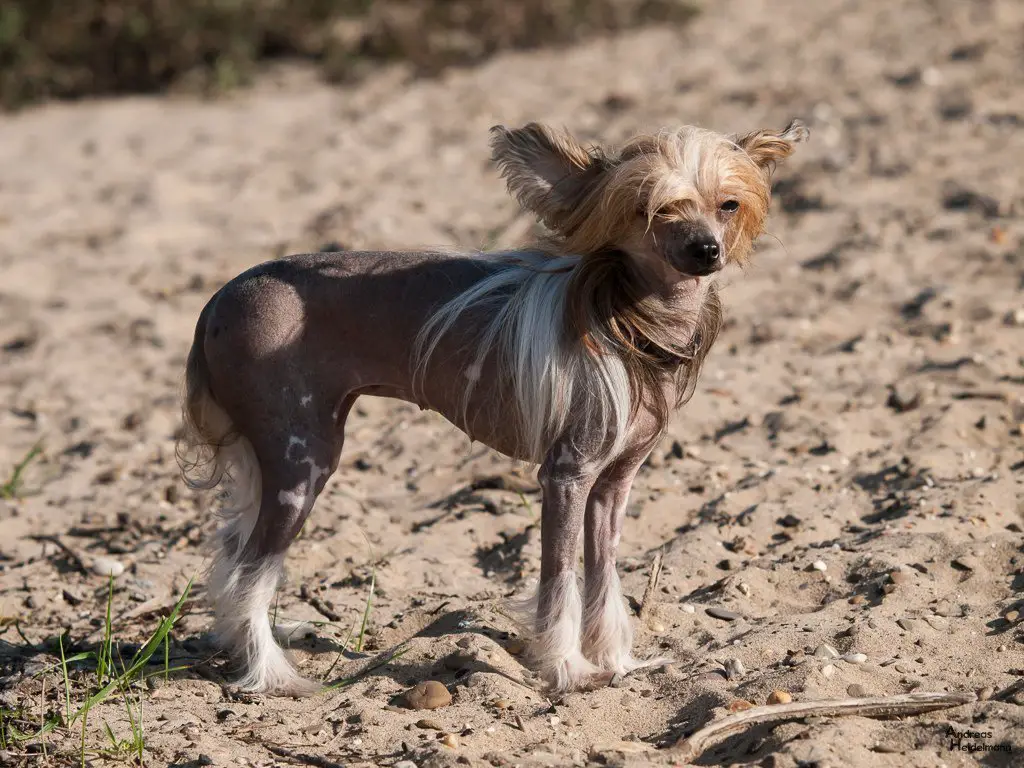
Chinese Crested dogs are relatively strong dogs, but they also have their own list of genetic ailments. Most often, representatives of this breed can be found:
- primary dislocation of the eye lens;
- progressive retinal atrophy;
- cataracts;
- dry keratoconjunctivitis;
- hyperuricosuria;
- degenerative myelopathy;
- epilepsy;
- Perthes disease;
- dislocation of the patella;
- hyperplasia of the joints (hip).
Of the ailments that are not caused by heredity, it is possible to note food allergies, which provoke skin rashes on the skin of naked “Chinese”.
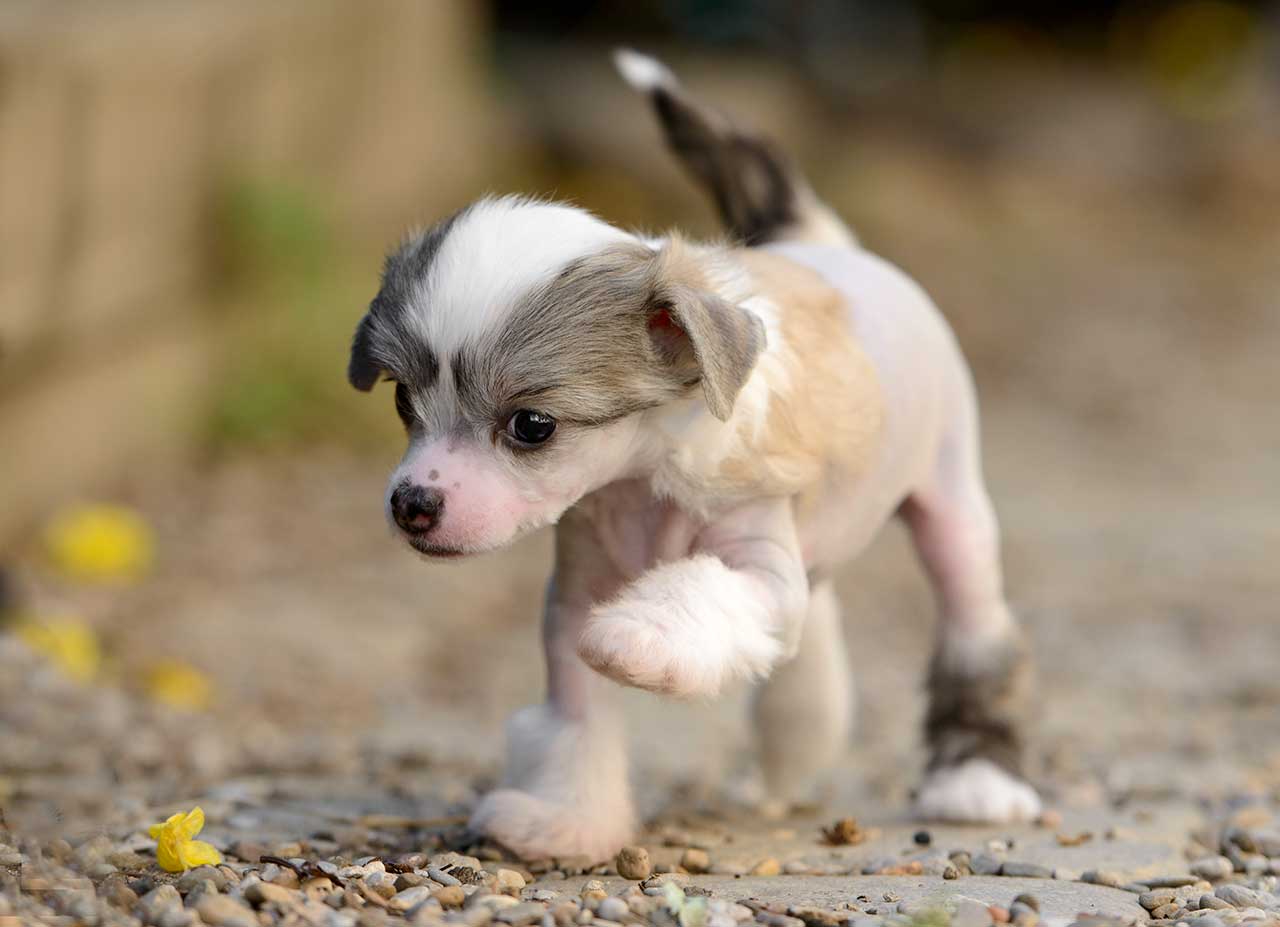
How to choose a puppy?
Chinese crested puppies are sold at the age of one and a half months, but nothing prevents you from visiting the nursery earlier to book your baby, and at the same time assess the conditions in which he lives. You should definitely get acquainted with the parents of the future pet or at least one of them. In the end, no one has canceled hereditary diseases.
As for the exterior, it is unstable in Chinese Crested puppies. Animals with black and chocolate fur brighten as they grow older, in many babies the proportions of the head change (the muzzle is lengthened), and the crest in most young individuals is not yet very pronounced and looks more like a hat.
If your choice is a naked Chinese Crested, pay maximum attention to the hair on the baby’s head and tail. For example, if the “forelock” and the plume are thick, this feature will appear brighter as they grow older. A sparse hair, alas, will not become more abundant. Sometimes puppies of hairless KHS can grow all over the body. This is not a defect. On the contrary, such individuals always have a more spectacular crest and tail. The only thing is that you will have to shave and epilate such a dog more often. Do not hesitate to look “naked” in the mouth to make sure that all of his teeth have erupted, or at least most of them.
When choosing between a dog or a female keep in mind that even the most intelligent Chinese “boys” mark their territory. In addition, having smelled the flowing crested “young lady”, they become uncontrollable and prone to escapes. For unsterilized “girls” the only problem is in heat, which occurs twice a year and lasts for 3 weeks. At the same time, throughout the entire mating season, the baby can leave bloodred traces of discharge in the apartment, which not every owner will like.

